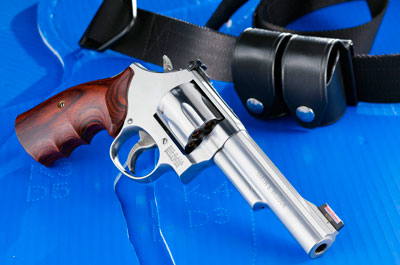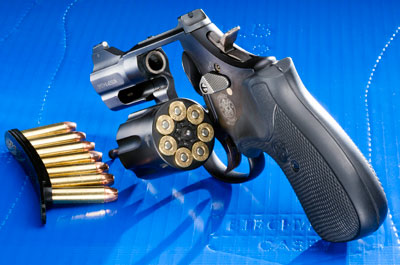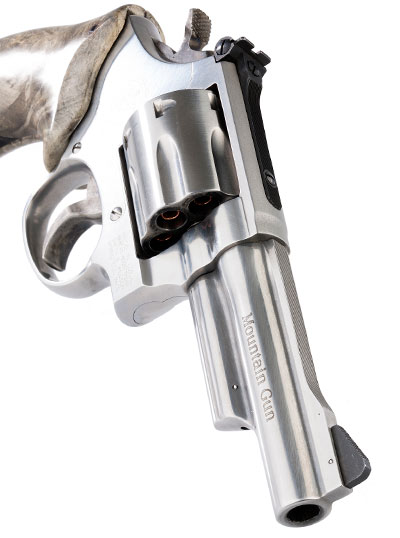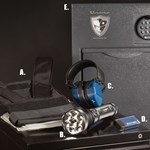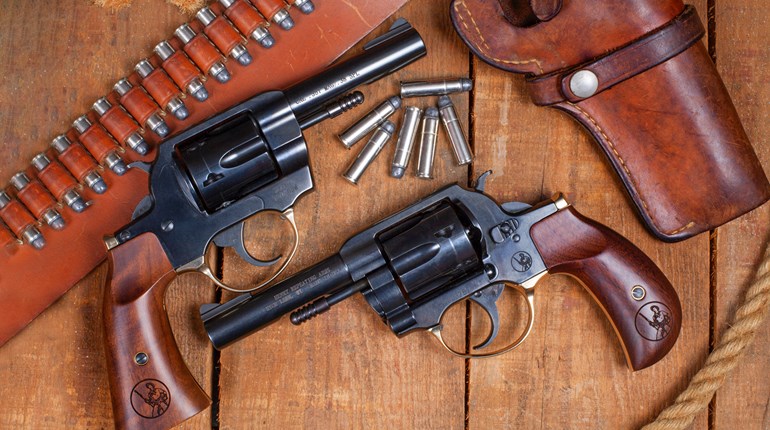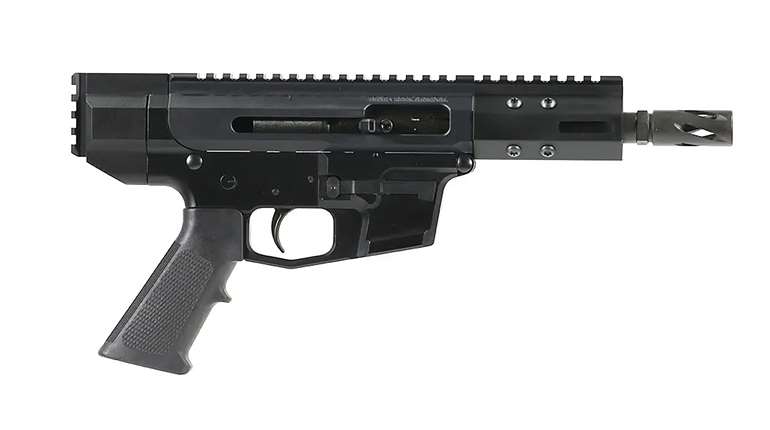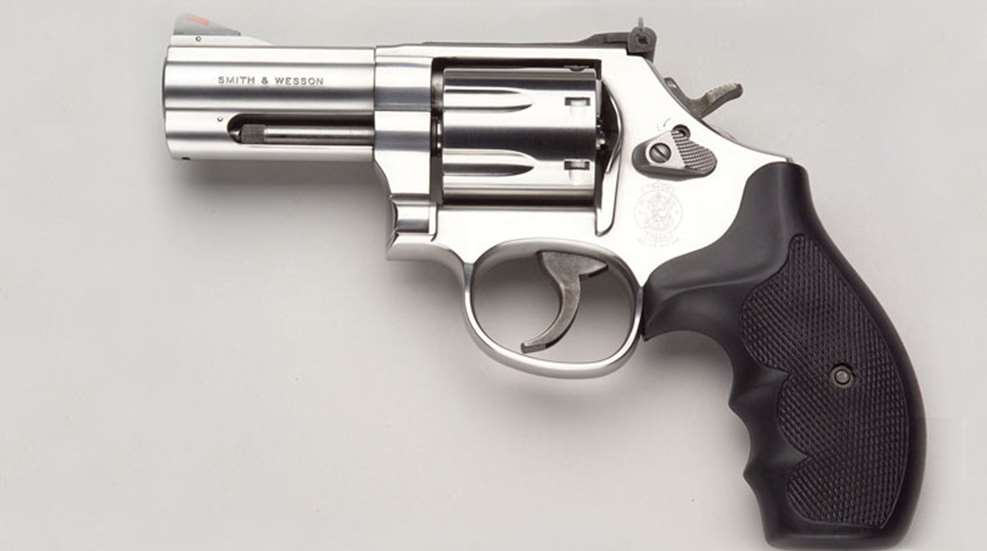
The handgunning scene of the 1970s was unlike today's. Semi-automatic pistol choices were far less varied, and concealed-carry handguns were almost always snub-nose revolvers. The grand old 1911 pistol was showing surprising signs of a renaissance, but the gun to have for police service was the century-old double-action revolver. Colt was fading fast in a market it once dominated, Ruger had made only modest inroads, and more often than not, the cop on the beat carried a Smith & Wesson.
The best of that breed was—and still is—Smith & Wesson's superb series of L-frame revolvers. This medium magnum came as a result of the continuing evolution of the K-frame M&P models introduced in 1899. The L-frames, engineered to handle the stresses of the .357 Mag., deserve to be understood by today's handgunners, so I'll tell their story here. To do so, we have to go back a few years to the beginning of the Magnum era.
On April 8, 1935, Smith & Wesson ushered in the Magnum era of handgunning with a new revolver. It was a brute-strong gun, fitted and finished to an unprecedented level of excellence. The big N-frame wheelgun fired a new, high-speed, heavy-bullet cartridge called the .357 Mag. Long-barreled versions of the revolver drove 158-grain bullets to speeds of 1,500 fps or more. Essentially the Magnum was a stretched .38 Spl., but the performance improvement in both gun and cartridge quickly developed enormous popularity. Nothing was ever quite the same again. People began to regard the .357 as a gun/cartridge combo capable of expanded roles such as long-range shooting, dangerous-game hunting and anti-personnel use. Six years after its introduction, the gun was out of production.
But that was only because everything else was likewise temporarily on hold; World War II production of military revolvers for the British took precedence. When the war was over and America entered a new era of affluence, all those GIs who learned their shooting skills from Uncle Sam came home. Many wanted to enjoy the shooting sports, including handgunning. Rather quickly, the civilian demand for quality revolvers was very strong, and one of the first guns in demand was the big, N-frame .357 Mag. Peace officers at local, state and federal levels were part of that demand. The police officer views his handgun as a tool of his trade. It's a tool seldom needed, but habitually carried. Believe me, there is nothing easy about carrying the original large-frame .357 Mag.
That's why big ol' lanky Bill Jordan suggested—in his own inimitable way—to Smith & Wesson that it make a target-grade, .357 Mag. on the smaller K-frame. Long associated with Smith & Wesson's .38 Spl. cartridge, the K-frame was the basis for the firm's mid-level service revolvers. Jordan wanted an easy-to-pack .357 with a heavier barrel, target sights and other features. This required a fair amount of mechanical engineering, as well as updated metallurgy, but it was eventually done.
The revolver was an instant hit and quickly became the gun to have in law enforcement. The most popular barrel length was the 4-incher, but some officers liked the longer 6-inch revolver and many also had a 2.5-inch variant, with the more concealable round butt. From the mid-'50s to the late '70s, Smith & Wesson's Model 19 (also known as the Combat Magnum) was a best-seller, firing a growing array of hot .357 Mag. ammunition.
In the long run, it was the ammunition that caused the decline of the Model 19 (or 66 in stainless steel) and drove the development of its replacement, the Model 686. Shooters wanted more and more in the way of performance from their .357 Mag. revolvers, and hotter ammo was the only way to get it. Lighter bullets at higher velocities became the style, and that meant powders that burned at higher temperatures in order to deliver higher velocities. Simply stated, this trend in ammunition was not matched to a similar trend in guns. Some of the ammo was not well suited to the metallurgy and/or the construction of a medium-frame magnum revolver. The suitability of the ammo, or lack thereof, did not commonly make for catastrophic failures in the guns, but often caused accelerated wear.
Smith & Wesson set out to rectify the situation. The company did so with a completely new series of revolvers built on a new frame, called the L-frame. Introduced in 1980, the L-frame guns had an immediately recognizable feature never before used by Smith & Wesson—a barrel underlug that ran all the way to the muzzle.
The opening roster of L-frame revolvers was pretty ambitious. Called the Distinguished Combat Magnum, the new guns came with 4- and 6-inch barrels, followed closely by 2.5-inch and 83⁄8-inch versions. In stainless steel, they were known as the Model 686, while blue-steel guns were called the 586. For the working cop on a budget, Smith & Wesson provided two different 4-inch, fixed-sight variants, the Model 681 and 581. When they were introduced in 1980, all variations were popular, with most individual officer purchases being the 686 with a 4-inch barrel. Many departments chose the lower-priced 681 and 581.
The important thing to remember is the L-frames were good enough to quickly supplant the K-frames. Those slightly smaller guns nonetheless were in their maker's catalog for another 20 years. L-frames were also popular with civilian shooters, particularly in the longer barrel lengths. Several K-frame models retained popularity for a time, but the development and introduction of the L-frame essentially killed the K-frame.
Why? What was so different about the newer model that it supplanted a gun that Smith & Wesson had made in the millions? The answer is deceptively simple: The L-frame is a bigger and heavier revolver, with more steel and greater strength in critical areas. While it is larger, it is not overwhelmingly so. It is still accurately described as a medium-frame wheelgun.
It is not a matter of scaling up the K-frame. L-frame size increases are not universal; the butt sections of the two models are almost identical in size. But look first at the cylinder diameters of the two guns, where the L-frame measures 1.557 inches and the K-frame is 1.449 inches. That's about 7.5 percent larger and enough to increase the cylinder-wall thickness over the bolt-stop notches, making a stronger gun. Also, the barrel-shank diameter is sufficiently larger to do away with the K-frame weakness, a flat spot at the 6-o'clock point on the rear end of the barrel. Add that heavy, underlugged barrel and upgraded metallurgy to the dimensional changes already noted, and you have a strong, modern revolver well-suited to any ammo made to SAAMI specifications. As a matter of fact, it could be said the L-frame was the first revolver Smith & Wesson specifically designed to handle the powerful range of .357 Mag. ammunition.
As we have already noted, acceptance of the L-frame was both strong and immediate. As the company had done with so many other models, Smith & Wesson listened to requests for special-edition L-frames. An early one that made very good sense was a 3-inch round-butt variant for a Federal agency that fielded both uniformed and plainclothes officers. The resulting gun filled the bill for both roles. There were also two large orders of L-frames chambered for .38 Spl., for reasons that escape me. To satisfy a continuing demand for a medium-frame, five-shot .44 Spl., the factory developed models in that configuration. They were made as steel revolvers with double-action trigger systems (Model 696) and as lightweight guns with internal-hammer, double-action-only triggers (Model 296). Several years ago, the company made an unknown number of 4-inch L-frames chambered for the .40 S&W cartridge. I believe they were intended for use in IDPA events, but they were also a viable choice as a medium-bore defensive revolver.
Thirty-plus years of making the L-frame revolver have now passed into history. The maker updated the basic revolver in several ways. One of the most innovative upgrades was the development of a seven-shot .357 Mag. cylinder. I can't quite figure out how the company was able to equally space seven chambers around a 360-degree cylinder (360 divided by 7 equals 51.428571...) but they did, because I have fired a lot of varied ammo from them in various models. The seven-shot variant is known as the 686 Plus.
I have had my share of L-frames for review, but before I was writing about them, I was carrying one. The last of several Smith & Wessons I used as a police officer was a blue-steel Model 581. This fixed-sight 4-incher was an exceptionally rugged and reliable police service revolver. I fitted a lightly modified set of K-frame target grips to the gun and had Larry Nichols do one of his superb, duty action jobs. Thus equipped, there was nothing to do but smile and sheriff.
Two other L-frames came along in my more recent times as a gunwriter.The first was the Model 686 Mountain Gun, a revolver that combined the modern strengths and advantages of the slightly larger L-frame platform with the traditional look of the N-frame 1950 Target series. The major feature of these guns was the classic tapered barrel, which harkens back to the glory days in the post-war era when Carl Hellstrom was in the corner office. This barrel contour has its origins in the pre-World War I Triple Lock revolvers (for the short, enclosed underlug) and the 1935 Registered Magnum (for its fluted sighting rib). It is a shape much beloved of old-style revolver fans. Unfortunately, the 686 Mountain Guns are long out of production, and the maker needs to run another batch of them.
More than a few readers have said another of my personal favorites is something they would buy if it were to become available again. That's a 5-inch L-frame. Smith & Wesson has made a couple of small runs of these things, each slightly different. The earlier one was a 686 with the full-length, original, heavy underlug. A related model was a 5-inch version with a short underlug much like the one found on the Model 66s. There also may have been another 5-inch with an unfluted cylinder. In K-, L- or N-frame Smiths, the 5-inch barrel is often initially overlooked, but serious shooters often take to it as the best compromise length for ammo performance, sight radius and handling.
Revolvers have come a long way as fighting handguns. They've armed a lot of good men and women. Most commonly, it was the medium-frame, double-action revolver that filled their needs. And for this devoted wheelgunner—with no disrespect to the creations of the Taurus forge and the Ruger foundries—the best of the breed in carrying wheelguns is an L-frame Smith & Wesson.
